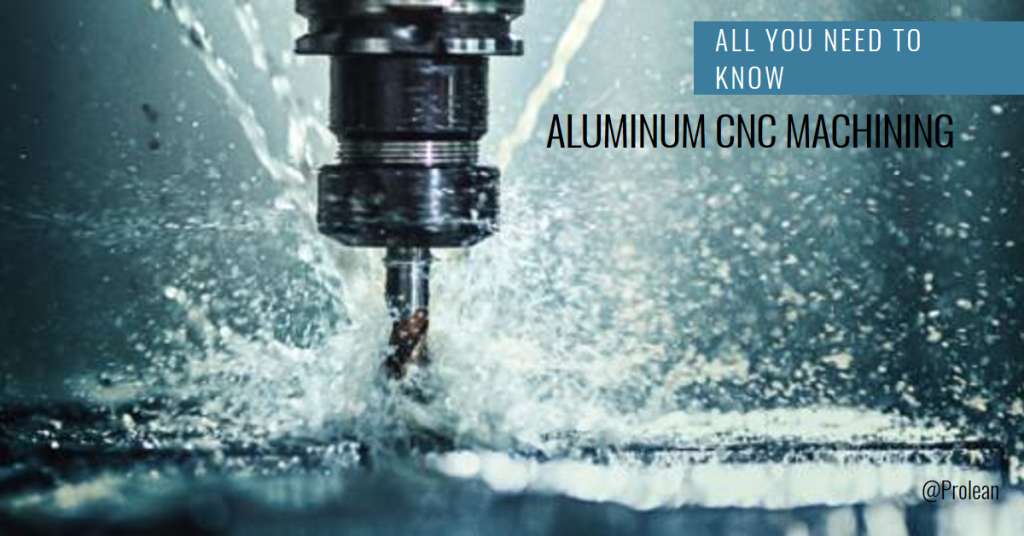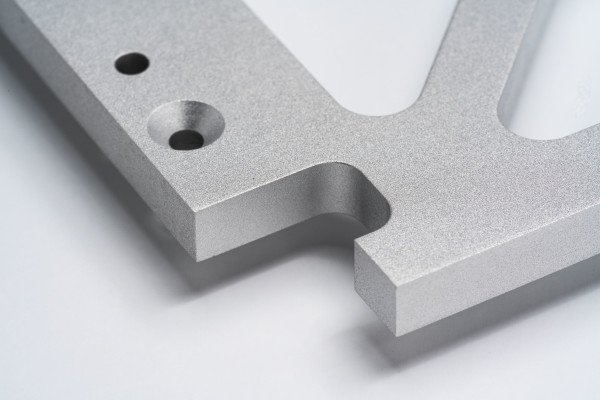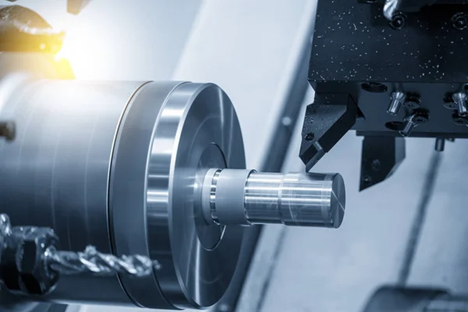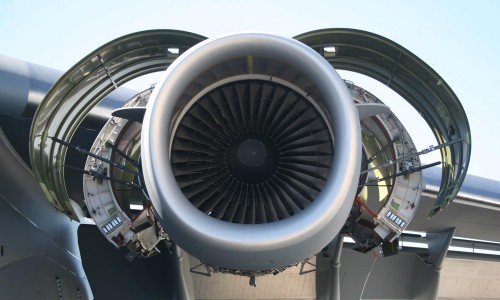Aluminum is a widely used material for CNC machining because of its diverse physical and mechanical properties. In addition, due to its excellent strength-to-weight ratio, aluminum and its alloys are best suited for manufacturing various components where greater strength is required, and weight is the main obstacle. As a result, it is used to make the components for products in multiple industries, including automotive, aerospace, defense, Electrical, furniture, and other home appliances.

The most popular grades of aluminium alloys for CNC machining, factors to be considered, benefits, drawbacks, and applications will all be covered in this article.

Aluminum CNC machining
Common Grades of Aluminum alloys for CNC machining
Aluminum grade-alloys series
Aluminum 2024
It is a heat-treatable alloy where copper is the primary alloying element. It is a soft, annealed alloy with good machinability properties, fully capable of resisting fatigue. Despite having lower corrosion resistance than other grades, it is the best material for machining aircraft components due to its excellent strength-to-weight ratio when the surface is appropriately finished.
Aluminum 6061
Magnesium, silicon, and aluminum make up Grade 6061, enabling heat treatment to higher strength levels. Due to its high strength, toughness, and bending workability, this grade is suitable for 5-axis CNC machining. Furthermore, since it has high corrosion resistance, it is also ideal for harsh environmental conditions. As a result, it can be used in various industries, from mechanical prototyping to aerospace and telecommunication.
Aluminum 7075
In grade 7075, zinc is the primary alloying metal. It has moderated formability as compared to other heat-treatable grades. In CNC machining, this grade is used to create various parts where a high level of toughness is required for functionality, from bicycle parts to aircraft wings. Although, it has a poor weldability character.
Aluminum 3003
It is made with manganese as a primary alloying metal. It is used in the production of household goods due to its excellent formability and ease of machining operations like bending, spinning, roll forming, and stamping. In addition, because of the superior corrosion resistance, the products can withstand the outdoor environment, which is also perfect for outdoor decorative and architectural components.
Aluminum 5052
5052 aluminum is primarily alloyed with magnesium and chromium, making it the most suitable for CNC forming operations. It has good workability and higher strength than 3003. Because it only offers a fair machinability rate, it is not a good choice for extensive machining operations. This grade is excellent for heat exchangers applications, general sheet metal work, and architecture.
CNC Machining Operations for Aluminum

Turning operation
1. CNC milling
CNC Milling is the most common operation of Aluminum CNC machining, which is capable of producing a wide range of shapes. In The milling operation, the Aluminum workpiece remains stationary. At the same time, the rotating tool performs a multipoint cutting along its axis to remove the material to get the desired shapes as per computerized controls. In some cases, the workpiece and the cutting tool move while the material is removed along multiple axes.
2. CNC-facing
With the aid of a CNC-facing operation, an aluminum workpiece with a rough surface can be made into a flat cross-section with the help of face turning or face milling.
3. CNC- drilling
In this process, a multipoint rotating cutter of a given size is moved in a line perpendicular to the outer surface and drilled to create the hole or other shapes at a set diameter and length.
4. CNC turning
In CNC turning, the chuck holds and rotates the aluminum rod, and the multipoint cutting tool removes the material till the desired dimensions and shape are not obtained.
Factors to be Consider for Aluminum CNC Machining
For quality CNC machining, you should try to choose an appropriate cutting tool, there are various factors such as tool material, Tool geometry, cutting speed, feeding rate, and cutting fluid.
1. Tool geometry
The productivity and quality of CNC machining for aluminum are impacted by tool geometry. Therefore, you must consider the following variables for effective machining.
- Flute numbers

A tool with three flute number
When performing CNC machining on aluminum, choosing cutting tools with two to three flutes is the best option. In contrast, choosing flute numbers less than two or more than three will result in giant chip formation and small chips leaving machining marks on the surface.
- Helix angle

Another element that influences the effectiveness of CNC machining is the helix angle. It can be characterized as the angle formed by the tool’s centerline and a straight line tangent to the cutting edge. The helix angle will determine how fast it will remove the chips. Choose a 35° or 40° helix angle for CNC machining aluminum, or jump up to 45° if you go for the post-surface finishing.
- Clearance Angle
A large clearance angle can excessively dig into the aluminum workpiece, and friction between the tool and the workpiece can be caused by a slight clearance angle. The ideal clearance angle ranges from 6 to 100.
2. Material for cutting tools
Carbide is the most typical material to create the cutting tools required for aluminum CNC machining. So it is because tools made of carbide are fully capable of withstanding the high cutting speeds needed for aluminum CNC machining.
Aluminum requires soft cutting, so the carbide’s grain size and binder ratio should be small. To make such, Cobalt must be mixed in the right amount to produce a small carbide grain size (2-20 %) ideal for soft cutting. Additional coatings like diamond and zirconium nitride can increase the effectiveness of the cutting.
3. Cutting speed
Aluminum can withstand high cutting speeds so you can set your CNC machine to any practicable speed. However, built-up edges can form when moving at low speeds.
4. Feed rate
The required finish and strength determine the feed rate. For example, you can choose between 0.05 and 0.15 mm/rev for a rough surface and 0.15 to 2.03 mm/rev for smooth finishing.
5. Cutting fluid
In aluminum CNC machining, the appropriate cutting fluids are soluble-oil emulsions and mineral oils utterly free from chlorine or active sulfur because these can stain the workpiece.
6. After-machining process

CNC machined parts with surface finishing
Post-machining processes are required to improve surface finishing, aesthetic beauty, and physical and mechanical properties. There are many post-machining processes for CNC machined aluminum parts, such as Bead and sandblasting, Coating, Anodizing, and powder coating.
- Bead and sandblasting: Aluminum machined parts are fired with tiny glass beads using a highly pressurized air gun, eliminating the remaining material to produce a smooth surface without compromising the dimension tolerance.
- Anodizing: Aluminum part is dipped in the sulphuric acid electrolyte, and electricity is applied across the cathode and anode. Oxide ions are released from the electrolyte to create non-reactive aluminium oxide for the exposed surface.
- Coating: simple coating with another substance like zinc, nickel, or chromium.
- Powder coating:high-temperature polymer powder coating of the component
Try Prolean Now!
Advantages of CNC Machining
Aluminum CNC machining has several benefits because of its mechanical and physical characteristics. For high precision CNC machining, it is very safe and straightforward. Let’s overview each of the advantages.
Machinability
Due to the soft nature of aluminum, there is almost no chance of deformation during CNC machining, and it chips easily. Therefore, it can be easily machined with tools without wearing them out.
Excellent machinability reduces machining cycle time while maintaining outstanding dimensional stability.
Strength-to-weight ratio
Aluminum is a light metal with excellent strength. If you compare it with steel, it is three times less dense, making it perfect for the application where the weight is the main challenge with keeping the high strength, such as in aircraft components.
Safe Machine Work
Aluminum does not produce toxic byproducts during CNC machining. Unlike other materials like plastic, it is entirely safe during machining operations.
Corrosion resistance
Due to the excellent affinity of aluminum and its alloys for oxygen, it cannot lose the rust’s oxide layer while exposed to moisture. Due to these characteristics, aluminum is a fantastic corrosion-resistant material. Corrosion resistance increases the longevity of the CNC machined parts.
Recyclability
All components and products made of aluminum using CNC machining are recyclable. As a result, aluminum components can be used again once a product’s life cycle is over.
Electrical conductivity
Due to their electrical conductivity, CNC-machined aluminum parts are also suitable for electrical components, though the conductivity could be decreased by alloying with other metals.
Aesthetic benefit
Although aluminum and its alloys can be CNC-machined to an excellent surface finish, they can also be anodized to obtain a variety of colors, which adds a very appealing aesthetic beauty to the parts and product.
Performance at low-temperature
Unlike other materials, aluminum retains its properties at very low temperatures, such as softness, elasticity, and strength. This quality makes it ideal for low-temperature operating parts.
Applications of Aluminum CNC Machining

Aircraft turbine cover made from Aluminum CNC machining
As previously mentioned in the article, Aluminum and its alloys have many advantageous qualities, making Parts from Aluminum CNC machining essential in several industries.
Aerospace Industry
Aluminum’s high strength-to-weight ratio and precision CNC machining make it ideal for various aerospace components, including airfoils, fitting & landing gear parts, bushings, and different electrical connectors.
Automotive Industry
Aluminum is capable of withstanding the higher weigh weight. Therefore, Various automotive parts are prepared through Aluminum CNC machining. Such as shafts, unique components, wall panels inside the vehicle, drive axels, gearboxes, starter motors, and many others.
Electrical Industry
Thanks to aluminum CNC machining, consumer electrical and electronics are getting smaller, have tighter tolerances, and are still lightweight. Circuit boards, heat sinks, and semiconductors are examples of parts.
Medical Industry
Aluminum CNC machining fills the need for medical equipment requiring lightweight and precision machining. Numerous research, surgical, and drug delivery components, including surgical implants, MRI machines, blade handles, cutters, and surgical scissors, are made with aluminum CNC machining.
Other applications
Baseball bats and sports whistles are examples of sports equipment. The food and pharmaceutical industries also use aluminum components created by CNC machining. Also, Cryogenic applications are numerous.
Conclusion
As you know from this article, aluminum has various properties and benefits for using its parts created through CNC machining. Due to the excellent machinability, tight dimensional tolerance is easily achievable. So, if you want to consider aluminum CNC machining for your project, our On Demand machining service is here to help you. We offer a professional CNC Machining service for all Aluminum parts. Here, our quality control engineers monitor each machining step to maintain the standard and tolerance. Feel free to contact us for more information
FAQ’s
What are the popular grades of aluminum alloys?
Aluminum 2024, 6061, 7075, 3003, and 5052 are the popular grades for CNC machining.
How Can I select the best alloy grade?
It depends on the products’ applications and the necessary mechanical and physical qualities, including hardness, strength, ductility, and conductivity. Because each type of alloy grade has unique properties, choosing the best grade can be challenging. So, let our professionals decide which is best for your project based on your requirements.
What are the factors for consideration in Aluminum CNC machining?
For the quality CNC machining, you should consider various factors such as tool material (Carbide), Tool geometry (Flute numbers, helix, and clearance angle), cutting speed, feeding rate, and cutting fluid.
Is Aluminum CNC machining expensive?
No, creating the aluminum parts with a CNC machine is a cost-effective process, especially in large quantities. In addition, we offer very competitive pricing. Contact us and get a quotation within 24 hours.
Are you a manufacturer?
Yes, we are a leading manufacturer of china. We can provide on-demand manufacturing services such as CNC-machining, sheet metal, injection molding, Aluminum Extrusion, and surface finishing.




In it different material facts. I agree with you, thanks for the help in this question. As always all ingenious is simple.
Hi Prolean
i am interested in information, which of these materials are mostly used for making boxes with heat sink: Aluminum 2024, 6061, 7075, 3003, and 5052.
best regards
Badri khvitia
Hello, Khvitia. Thank you for your comment. Generally, 6000 series aluminum alloys are suitable for heat sink applications, so 6061 could be a best choice for this project. However, we advise to choose the grade according to end-application of product and other specifications. If provide the more details, we can help you with material selection & manufacturing.
+86 15361475335
+44 7729718039
quotes@proleantech.com